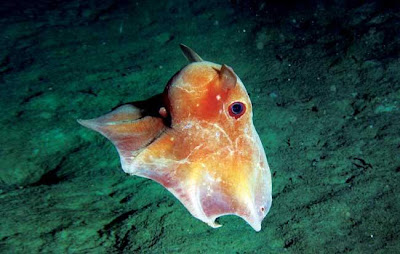It's the 104th anniversary of Rachel Carson's birth. She was with us for only 56 years�not nearly long enough.
Last year I had the privilege of writing an afterword for a fine-press limited-edition book of Carson's first published work, a lyrical essay called Undersea. The publisher of this volume is Nawakum Press, the preface by environmental historian and biographer, Linda Lear, and the illustrations by author, designer, and illustrator, Dugald Stermer.
I'm grateful to Nawakum Press, who have been kind enough to let me post the afterward to her beautiful Undersea here.
So, happy birthday, Rachel Carson! This is for you.
So, happy birthday, Rachel Carson! This is for you.
Afterward
It's impossible to read Rachel Carson's deeply insightful essay 75 years after its publication and not run afoul of a sad truth: that she is not here to enjoy the plethora of new revelations emerging from the undersea world. Since her death in 1964, scientific investigation has illuminated much of the "eternal night" of her abyss. Already, tens of thousands of species have been added to the 230,000 species of marine animals known by the close of the 20th century. Our discovery of these new "folks" is not the consequence of a handful of men leisurely sailing the blue, but of thousands of women and men exploring every corner of the World Ocean with deep-towed cameras, sonar, submarines, remotely operated underwater vehicles, free-swimming autonomous underwater vehicles�an ever-evolving host of technologies allowing us to know what no one in 1937 could have imagined...
(Cirrate, or dumbo, octopod. Credit: Michael Randall.)
This cooperative endeavor has swelled Carson's beloved catalogue of periwinkles, starfish, and crabs to include otherworldly marvels: Dumbo ocotopods who swim by flapping earlike fins; wildcat tubeworms who drill for and feed on chemicals in decomposing oil; southern elephant seals who dive a mile and a half deep in search of prey living below the cusp of perpetual darkness; shoals of fish 20 million strong, swimming in schools the size of Manhattan.
(Tubeworms, Lamellibrachia luymesi, from a cold seep 550 meters/1,800 feet deep in the Gulf of Mexico. Photo: Charles Fisher via Wikimedia Commons.)
Many discoveries have emerged from abyssal ecosystems unknown to Rachel Carson. The first hydrothermal vent was discovered only in 1977. The first cold seep in 1984. Carson understood the deep was fertilized by outflows from rivers, volcanoes, meteorites, and the rain of detritus from the ocean's surface. She could not have envisioned how the gas-fueled communities of the coldest abyss could feed themselves� how extremophile lifeforms could adapt to intense pressures and a sunless world and thrive in "lifeless" conditions by harvesting chemosynthetic�not photosynthetic�energy from hydrogen sulfide and methane.
(Whale fall. Credit: NOAA.)
In Undersea, Carson marvelled at the resilience of the ear bones of whales and the teeth of shark that endured all the way to the bottom of the ocean. Imagine how she would have thrilled at the 1987 discovery of whale falls�those oases created by the sunken bodies of dead whales, each home to its own extremophile metropolis gathered to feed on the fallen bonanza of skin, muscle, bone, and blubber. Whale falls today are estimated to number some 850,000 worldwide, with many millions more in the recent past, before the age of commercial whaling reduced global whale populations by 90 percent. Each fallen whale is an island of life-support with a hundred-year-plus lifespan.
(Lobster egg. Credit: Tora Bardal, from Nikon Small World 2009.)
The underwater world we've discovered since Carson's day redefines the old superlatives. Today's finds are bigger, deeper, darker, colder, farther, older. Technology combined with a growing lineage of scientific knowledge allows us to explore the heretofore unknowable. We visit communities of life thriving in blackness 2,300 feet below Antarctic ice. We follow pairs of mated seabirds flying 44,000-mile figure-eight loops around the Pacific in the 200 days between their nesting seasons. We rediscover Jurassic shrimp "extinct" for 50 million years alive and well in the Coral Sea. We magnify ocean water and find bacterial species in excess of 10 million.
Our sorrow at the absence of Rachel Carson in this expansive world is mitigated by another sad truth. The same alarming developments that compelled her to sound the clarion call of Silent Spring only a quarter century after the lyrical Undersea are evolving dangerously today. Delving deeper, we find the depths suffering from overfishing, pollution, dead zones, acidification. Scrambling to uncover new species, we find them disappearing faster than we can reach them, with more than a third of scientifically assessed species now in danger of extinction. Since Carson's hand helped guide the helm, the ship of science has shifted course to sail head-on into a typhoon of human excesses: habitat destruction, biological invasions, global-warming, overpopulation. The world Rachel Carson loved and defended grows more silent spring, summer, autumn, and winter.
(Robert Hines and Rachel Carson. Credit: USFWS.)
In the course of her all too short life, Carson had opportunity for only one brief dive below the surface, donning an old-fashioned diving helmet to stand upright in a hard current in bad visibility. Perhaps we could indulge a small literary license and take her underwater with us now�with modern equipment in excellent conditions. If she is tentative, as many novice divers are, we can offer her our hand to hold and descend together, taking the time to clear our ears, adjust our buoyancy. Somewhere along the free fall to the bottom, perhaps as the sea fans and anemones and shoals of fish begin to come into focus, she will let go our hand. Imagine the moment: the slim figure gently kicking her fins to hover over a reef and inspect a familiar tube worm. Worries about scuba tanks and regulators now forgotten, she wafts weightless through shafts of sunlight, afloat in blue wonder, Rachel Carson home at last.
(Credit: slattery.matt at Flickr.)









Tidak ada komentar:
Posting Komentar